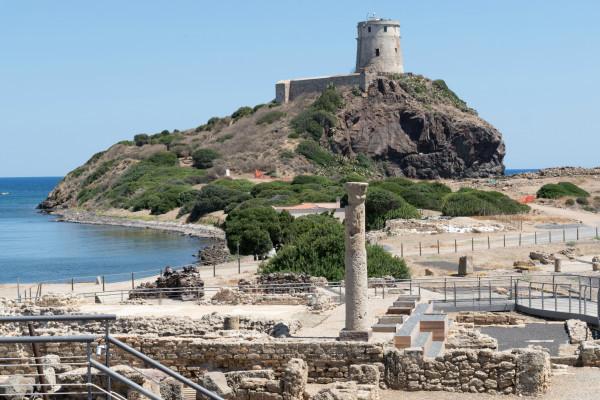Excursion through the ancient Roman ruins of the first Sardinian Phoenician City: Nora. The theatre, the thermal baths, the patrician villas, the marketplace recall a glorious and never forgotten past. Among the extraordinary streets, it will be possible to discover the urban and artistic techniques used by the ancient Mediterranean population.History is alive and in abundance on the island of Sardinia. This tour is your opportunity to visit some of what remains of a civilization that is approximately 3,000 years old! Enjoy a private guided visit tour to Nora and the hidden gem town of Pula.
- Discover the ancient Roman city of Nora
- See the ruins of a Roman settlement
- Visit the historic downtown of Pula
- Experience Sardinia like a local
| Included | Bottled water Tickets Pick-up/drop-off only for Domus de Maria and Chia area Skip the line Private Tour Transport by air-conditioned minivan with wifi free service, due to availability, please be aware that vehicles used in the excursions may be different from description and vary at the management's discretion. |
|---|---|
| Not included | Gratuites |
| Duration | 4 Hours |
| Participants | 8 |
| Important information | Wheelchair accessible(Including all surfaces, but not the vehicle) Infant seats available Stroller accessible Please be aware that beyond the time limit of the cancellation policy, it is not possible to amend or cancel bookings in any way, including health conditions. The only exception for changing dates is only with a certificate of positivity of Sars Covid 2. The excursion will not be cancelled and refunds will not be issued in case of rain |
Further information
Departing from Chia, your trip to Nora will be about 20 minutes.
Nora was the first Phoenician city in Sardinia (8th century BC), an essential commercial crossword and port of excellent location, in the isthmus of Capo Pula, from which it was possible to set sail in any weather. Nora, which developed fully in the 4th century BC under Punic rule, was conquered by the Romans in 238 BC and became a municipium in the 1st century AC. During the two following centuries, it lived its maximum splendor: urban growth and eight thousand inhabitants and being caput viae, the starting point of all of the roads on the islands. In this flourishing city, fascinating remains can be seen at the archaeological park of Pula, a handful of minutes from the tourist center, and findings exhibited at Patroni Museum. Go snorkeling and admire Roman roads and remains at the bottom of the isthmus, at Punta del Coltellazzo, dominated by a 16th-century tower. Roman edifications covered almost all evidence of Phoenician-Punic times. Excavations began in 1889 when a coastal storm revealed a Phoenician-Punic cemetery (Tophet), bringing to light the remains of the Temple of Tanit, a Carthaginian goddess, and the Nora Stone in the Museo Archeologico di Cagliari (National Archaeological Museum). On the stele, the most ancient document of the Western world, the name Shrdn, Sardinia, appears for the first time. The Tophet sits near the Little Romanesque church, the place of martyrdom of the warrior saint remembered every year during Sagra di Sant’Efisio, of whom the Pula population is particularly devout. At the entrance to the park, you will find remains of the thermal baths that made Nora famous. Take the cobbled streets to enter the heart of the ancient city: Piazza del Foro. Nearby there is a temple with a six-column entrance hall (pronao), while to the north, you will find the necropolis and the aqueduct.
You will come across a nobleman’s house on the coast, the house of tetrastyle atrium from the 3rd century AC, with a four-column portico and rooms lined with mosaics (do not miss “Nereid on a marine centaur”). Keep walking, and you will see its main attraction, the theater: lined initially with marble, it had twenty terraces and could seat one thousand people. Today it hosts the La Notte dei Poeti festival. To the south, Aesculapius’s sanctuary, with a mosaic-lined terraced from the 4th century: perhaps the set of the incubation rituals to ask the gods for remedies. It is the last most fabulous building: Nora began to decline in the 5th century.
You will also visit the nearby town of Pula. A hidden gem in southern Sardinia, with charming alleys and patrician homes. You can browse your perfect souvenir here; there are many craft shops.
Throughout this incredible experience, your guide will strive to make your time as personalized as possible.










